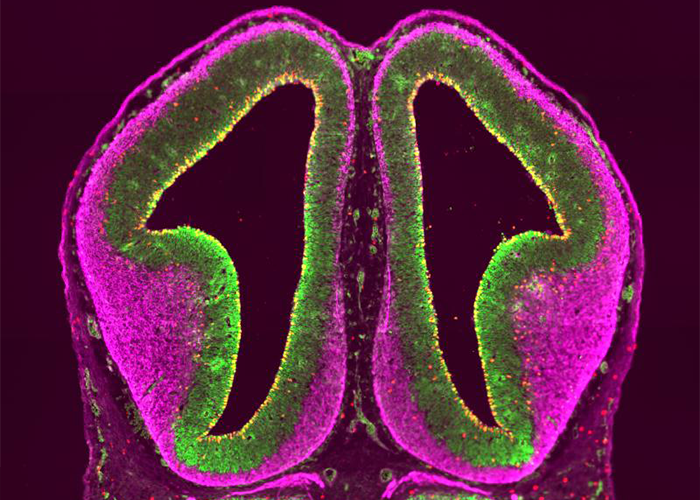
If 98.8% of our DNA is the same as that of a chimpanzee, then what changes in that remaining 1.2% make us human? Duke researchers are discovering how small differences contribute to the defining traits of the human brain. Results are published in the journal Nature.
Debby Silver, PhD, professor of molecular genetics and microbiology, together with lead author and senior research associate Jing Liu, PhD, and team, focused on genetic elements called Human Accelerated Regions (HARs) – highly conserved stretches of DNA that do not encode for protein but are located near genes involved in brain development.
There are an estimated 3,000 human accelerated regions in our genome. Focusing on just one HAR, Silver said, “We were able to unearth new functions for human-specific elements that control the ability of progenitors to make neurons.” In other words, they discovered how small changes can have major impacts on the development of the cerebral cortex, which is the part of the brain responsible for higher cognitive functions.
In humans, the cerebral cortex is larger and has more folds, allowing for more neurons. These neurons form complex neural circuits responsible for abstract reasoning, emotional regulation, language, and artistic expression.
Using a genetically engineered mouse model with this human HAR, they observed that these mice had slightly larger cerebral cortexes and more neurons than the control mice. These changes trace back to activity in the Wnt signaling pathway – a key regulator of progenitor cell proliferation and neuronal differentiation.
They also edited human stem cells to include the chimpanzee version of the HAR, which differs by just four nucleotides, and saw less neural progenitor proliferation. But if they put the human nucleotide sequence into chimpanzee stem cells, neural progenitor proliferation increased.

“We’re exposing one of the mysteries,” Silver said, “of how these small differences in our DNA can contribute to known anatomical differences.”
There is a downside, though, to having bigger brains. “Over the course of evolution,” Silver said, “we’ve acquired changes that have helped to collectively contribute to making us human, but with those changes, there also becomes an increased propensity for disease.”
Liu and colleagues observed there are gene variants associated with autism in this HAR sequence. “This reinforces the importance of studying this locus in particular,” said Silver. “These comparative approaches can tell us about the molecular mechanisms that make us human and can tell us about molecular features that may make us more prone to diseases.”
This is just one piece of the puzzle. “We’re studying just four changes in one transcriptional enhancer, Silver said, “so the changes we are seeing are subtle.” The more pieces of the puzzle you can fit together, the broader picture you can get on exactly what makes us human.